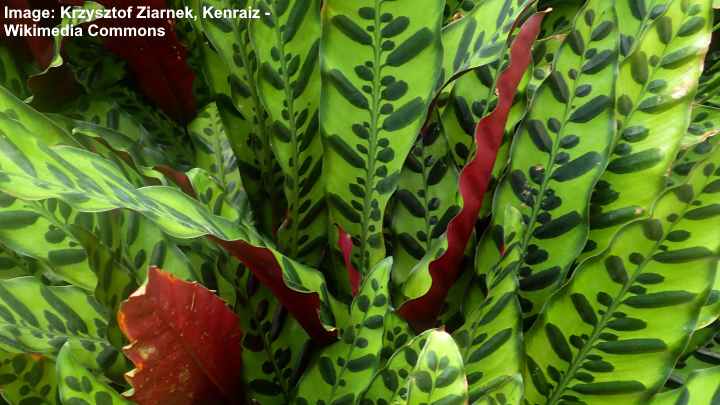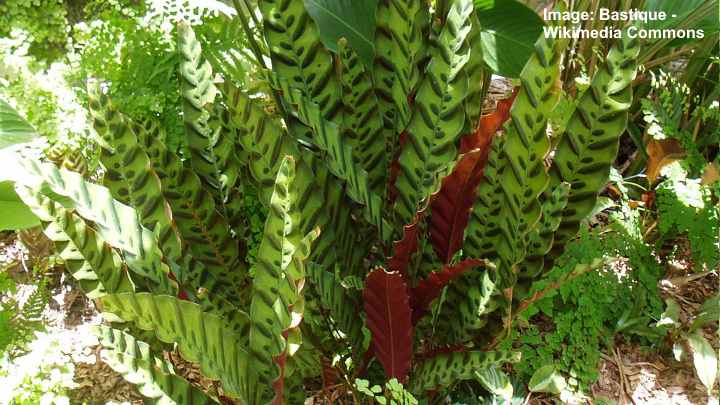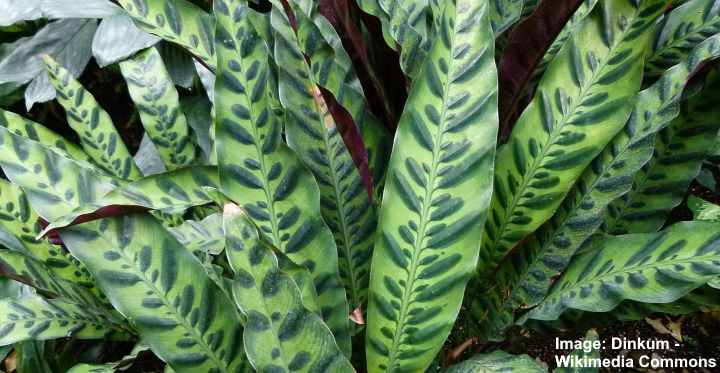Calathea lancifolia is a slender pointed leafed tropical houseplant with light and dark green patterns that is popular as an attractive houseplant. The lance-shaped leaves, which have black ellipse designs on the upper side and purple colors on the underside, are the main feature. Calathea lancifolia is a quick-growing evergreen plant that thrives indoors. Any indoor décor is enhanced by the exotic foliage of the rattlesnake plant.
Just one of the several Calathea species that flourish indoors is the Calathea lancifolia. Calathea ornata (pinstripe plant), Calathea orbifolia (jungle velvet calathea), and Calathea warscewiczii (jungle velvet calathea) are some of the other kinds of Calataea.
Because of the blotchy patterns on the leaves, the rattlesnake plant resembles the ‘peacock plant’ (Calathea makoyana) best of all Calathea species. Growing Calathea lancifolia at home is covered in this article. You’ll discover answers to numerous issues affecting this tropical houseplant’s development, in addition to beneficial growing guidance.
How to Care for Calathea lancifolia
The rattlesnake plant should be grown in bright, indirect sunlight to care for Calathea lancifolia. A porous, well-draining potting media is ideal for growing this calathea plant. To keep the soil moist but not waterlogged, water it frequently. Humidity should be medium to high, and temperatures should be between 65°F and 75°F (18°C and 24°C).
Calathea lancifolia (Rattlesnake Plant) Facts

Calathea lancifolia is a tropical evergreen plant that has patterned leaves with purple-maroon undersides. It’s related to prayer plants (Maranta) and belongs to the plant family Marantaceae. Calathea lancifolia thrives in the warm, humid environment of rainforests where it grows in dappled light.
Calathea lancifolia grows to be 24″ to 30″ (60–75 cm) tall as a tropical foliage houseplant. The elongated slender lanceolate green leaves have strong dark green patterns that help give it a bushy, spiky look. The underside of the calathea leaves becomes a lovely burgundy-purple when they fold up.
The tropical indoor plant Calathea lancifolia is commonly grown. The plant solely thrives in USDA zones 11 and 12 outdoors. In Hawaii and some southern parts of Florida and California, this limits your ability to cultivate them in your yard. The distinctive rattlesnake-like markings on the slender, wavy green leaves gave the Calathea lancifolia its common name, rattlesnake plant.
Calathea lancifolia Flowers
A blooming perennial with little yellow flowers, Calathea lancifolia is a flowering plant. This Calathea species blooms late in the spring in its natural habitat. The rattlesnake plant, as a houseplant, seldom (if ever) blooms indoors. Calathea lancifolia, on the other hand, is not cultivated for its flowers but for its tropical foliage.
Calathea lancifolia Leaves

Calathea lancifolia leaves are thin green blades that are narrow and long, with wavy borders. Dark green leaf-like designs run down the length of each side of the leaf’s center, alternating. The rattlesnake plant’s tropical appeal is enhanced by its wavy leaf margins and purple undersides.
The leaves of Calathea lancifolia may be up to 18 inches (45 cm) long. Calathea lancifolia leaves have features that are similar to those of prayer plants because they belong to the family Marantaceae. The pointed leaves fold up in a prayer position in the evening and then raise up in the morning.
How to Care for Calathea lancifolia
At home, Calathea lancifolia is very easy to care for. When it comes to light, heat, and humidity, calathea rattlesnake plants can be fussy. The soil must be kept moist, and the leaves must be protected from direct sunlight, according to the most important calathea care requirements. Let’s take a closer look at how to cultivate Calathea lancifolia indoors.
Where to Grow Calathea lancifolia
A warm, well-lit environment is ideal for Calathea lancifolia. It might be kept in a bright, east- or west-facing room without being in direct sunlight. This heat-loving plant may alternatively be kept in an indoor patio or conservatory. Another option is to put a tropical touch to a dimly-lit room by growing calathea rattlesnake plants in a shaded corner. The dark green patterns on the leaves, however, may fade if there is not enough bright light.
Light Requirements for Growing Calathea lancifolia
If it is shielded from direct sunlight, Calathea lancifolia thrives best in bright light. The calathea rattlesnake patterns may fade as a result of the sun’s intense rays bleaching the leaves. Brown scorch patches on the leaves may also be a result of overexposure to the sun.
You should cover the potted calathea plant with a sheer curtain if it is in direct sunlight. Drooping growth and faded leaves are two indications that the Calathea lancifolia lacks light. Despite the fact that most calathea plants can tolerate low-light situations, growth slows. Move the calathea to a brighter location if you notice that the stems and leaves are wilting.
The Best Soil for Calathea lancifolia Plants
In loose, organically rich potting soil with excellent drainage, Calathea lancifolia thrives. A combination of two parts peat moss and one part perlite is the optimum soil for most calatheas. Calathea’s roots are kept hydrated by Sphagnum peat moss, which provides nutrients. Perlite is added to amended homemade houseplant soil, which improves drainage. Calathea lancifolia plants should have the best soil for them to allow water to freely pass through it.
The soil should not dry out too quickly that the roots do not have enough moisture. Soggy, waterlogged potting mix is the worst thing for any type of calathea. There are a variety of reasons why soil moisture might be excessive. Calathea soil may get excessively wet for a variety of reasons:
- You should replace the potting soil with peat moss and perlite because it is too thick.
- You’ll have to repot the calathea since it’s rootbound.
- The pot has no drainage holes.
How to Water Calathea lancifolia Houseplants
During the spring and summer, water a Calathea lancifolia enough to keep the potting mix wet. Watering calatheas with the top layer of soil virtually dry is a beneficial method. Next, until the drainage holes in the pot are filled with room-temperature filtered water, drench the soil.
A calathea may need watering every week in the summer. A Calathea lancifolia plant in the winter needs less watering. You may watering the plant when the top layer of soil is dry to touch throughout the winter, and Calathea growth slows down. Over watering a Calathea lancifolia houseplant stresses it either too much or not at all. In addition, repeatedSoaking of the soil causes root rotting, yellow foliage, and eventual plant death.
Temperature Requirements to Grow Calathea lancifolia
Typical room temperatures are suitable for Calathea lancifolia. Calatheas should be maintained between 65°F and 75°F (18°C and 24°C) in their ideal temperature range. The plant needs to be protected from extreme temperature changes in order to thrive.
As a result, by protecting the plant from chilly drafts and heat vents, you’ll avoid stressing it. The cold doesn’t sit well with Calathea lancifolia. It has a minimum temperature of 60°F (15°C). When the temperature drops in the fall, bring your tropical houseplants inside.
Humidity for Calathea lancifolia Indoor Plants
The average household humidity is usually too low, so Calathea lancifolia grows in warm, humid conditions. Place the calathea pot on a tray with pebbles and water to increase room humidity. To increase air moisture and prevent brown foliage, you can use a room humidifier.
Daily misting of Calathea lancifolia leaves is also an option. Regularly misting calatheas, on the other hand, is impractical and time-consuming.
Regularly wipe the leaves with a damp cloth once a week as part of your Calathea lancifolia care routine. Not only does cleaning the leaves preserve their appearance and hydrate them, but it also stimulates growth. You may appreciate its leafy tropical green and purple leaves in this manner.
Calathea lancifolia Growth Rate
When growing in bright conditions, Calathea lancifolia has a medium growth rate. Rattlesnake plants are typically grown to a height of 2 to 3 feet (0.6 to 1 m) before they stop growing. Growth will slow significantly in low-light and winter conditions.
The Best Fertilizer for Calathea
During the growing season, Calathea lancifolia benefits from monthly applications of diluted houseplant fertilizer. Extra nutrients are helpful to promote development and ensure lush, exotic foliage throughout the spring and summer. NPK ratings of 10-10-5 are suggested for the best fertilizer to use.
A buildup of mineral salts causes root burn in the Calathea lancifolia rattlesnake plant. As a result, it’s recommended to flush the soil with distilled or filtered water every two to three months. For a minute, run water over the potting soil to wash away mineral salts.
Pruning Calathea lancifolia
Pruning Calathea lancifolia is not usually required. Remove decaying or dead leaves and stems from the plant, and it will get all of the attention it needs. Cutting the stems at the base of yellow or dying leaves allows you to prune them. Calathea plants’ energy is concentrated in new growth when pruning dead leaves.
Repotting Calathea lancifolia
Every year in the spring, repot a Calathea lancifolia for optimum growth. Carefully remove the plant from the pot, avoiding to harm the roots. Examine the roots for damage and remove any dirt. For calatheas, half-fill a new pot with a soil mix. The calathea should be replanted at the same level it was before.
Select a suitable pot that is one or two sizes bigger than your Calathea lancifolia’s current pot if it is still alive. The roots have more space to develop in a slightly bigger container, which prevents moist soil. The following are signs that it’s time to repot a Calathea lancifolia:
- Pot roots protruding from the bottom
- Water takes longer to drain the higher the elevation.
- The growth of plants slows as the temperature drops and
How to Propagate Calathea lancifolia
When repotting Calathea lancifolia, dividing the plant is the most effective way to propagate it. All you have to do is divide the roots by the number of new plants you want to create. Fill a pot with a appropriate potting soil and water thoroughly before placing the new plants. Place the growing plants in a bright location with plenty of moisture.
Is Calathea lancifolia toxic?
Cats and dogs are not poisoned by Calathea lancifolia. Plants from the Calathea genus are classified as non-toxic houseplants by the ASPCA.
Pests Affecting Calathea lancifolia Growth
Common houseplant bugs, mites, and pests are resistant to Calathea lancifolia. Spider mites, mealybugs, and aphids are all possible offenders. Every seven days, apply a natural neem oil solution to get rid of plant pests. Add 2 tsp. of sugar to the mixture. 1 tsp. of neem oil and A quart (1 liter) of warm water and dish soap To get rid of plant bugs, spray the calathea leaves liberally once a week.
Plant pests can be difficult to identify on Calathea lancifolia foliage, so it’s important to understand the symptoms. The following are some of the most common calathea pests:
- Spider mites—Look for thin silky webs beneath the calathea leaves. Before you see the white, black, tan, or red spiders, you’ll usually notice the webbing.
- Mealybugs—Look for white creatures that seem fuzzy and are small. White woolly stuff on plant leaves is another symptom of mealybugs.
- Aphids—Little pear-shaped creatures on plant stems and leaves, these plant-destroying insects seem to be.
Most tropical houseplants will have few, if any, pests if you take care of them well.
Diseases Affecting Calathea lancifolia Growth
Excess soil moisture leads to fungal diseases in Calathea lancifolia plants. The roots may rot if the soil is insufficiently drained or if it gets too wet. This causes the plant to slow down. Leaf spot, yellowing leaves, drooping development, and mortality are all symptoms of calathea plant disease. Never overwater your plant, because it will prevent any fungal or bacterial illnesses from infecting it. Only moisten the calathea soil enough to keep it from becoming waterlogged or soggy.
Calathea needs to be repotted with fresh potting soil every year to avoid soil compacting. Remember to add perlite, orchid bark, or gravel to the potting soil to improve drainage for your houseplants. Planting Calathea lancifolia in fresh potting soil is recommended if your plant exhibits symptoms of disease.
Before transferring to a new pot, check for any mushy brown roots and trim them. Finally, keep an eye on your lovely tropical calathea and don’t overwater or underwater it in the future. Unfortunately, you may have to cut your losses and replace the plant if root damage is severe.
FAQs — Calathea lancifolia Care
Despite the fact that the Calathea lancifolia is a low-maintenance tropical houseplant, it may experience problems with its development.
Why are my Calathea lancifolia leaves not opening?
Calathea lancifolia leaves may be closed or fold during the night for a variety of reasons. Soil that is too dry or there is too much bright light are the most common causes. Low to medium light, and moist soil are preferred by Calatheas. Increase humidity or relocate the plant to a less sunny area in order to get it to pray at night.
Why are my Calathea lancifolia leaves drooping?
Your plant is likely thirsty if you notice wilting calathea leaves. After that, water the plant to help it recover from its dry state. It’s also vital to not overwater the tropical houseplant. Its development is further harmed by chilly breezes.
Why are my Calathea lancifolia leaves turning yellow?
Yellow leaves may appear on Calathea lancifolia for a variety of reasons. Yellow calathea leaves may be caused by too much soil moisture, excessive exposure to the sun, excessive fertilizer, or dry soil. Check the care of the fussy houseplant to make sure no more leaves turn yellow.
It’s useful to remember that older calathea leaves usually turn yellow. So don’t be concerned if you only have one or two yellow leaves. To improve your plant’s appearance, prune the leaf stems at their base.
Why do my Calathea lancifolia houseplant leaves have brown tips?
Calathea lancifolia leaves with brown, crispy tips are more likely to occur due to low humidity. To prevent calathea leaves from curling and becoming brown, increase humidity and provide additional air moisture. Moreover, mineral salt accumulation in the potting soil might be indicated by brown leaves.
Overfeeding or using tap water to water plants may both contribute to this. As a result, it’s a good idea to wash the soil to get rid of excess minerals. To avoid leaf browning, it’s usually recommended to use filtered or distilled water when watering tropical houseplants.
How to revive a Calathea lancifolia?
It’s important to understand why a Calathea lancifolia is dying in order to bring it back to life. To hydrate the thirsty roots, thoroughly douse the soil with water if a lack of water or dry soil is causing foliage and stems to wilt. You’ll need to repot the plant in fresh soil and remove any dead or decaying roots if root rot is affecting the plant’s growth.
